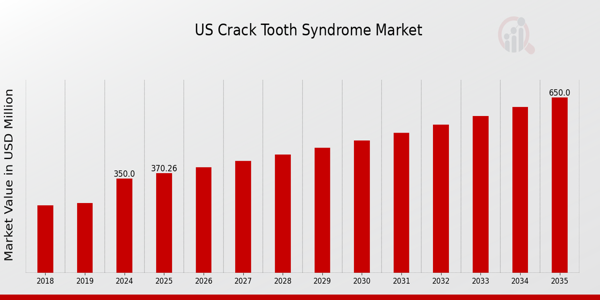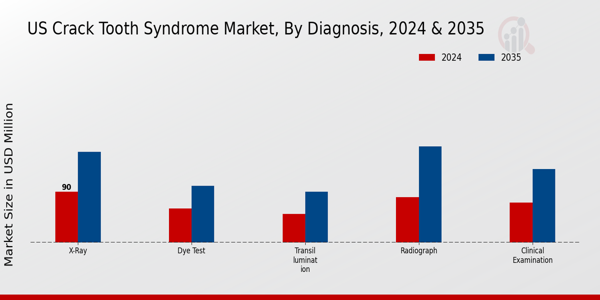US Crack Tooth Syndrome Market Overview
As per MRFR analysis, the US Crack Tooth Syndrome Market Size was estimated at 295.75 (USD Million) in 2023. The US Crack Tooth Syndrome Market Industry is expected to grow from 350(USD Million) in 2024 to 650 (USD Million) by 2035. The US Crack Tooth Syndrome Market CAGR (growth rate) is expected to be around 5.789% during the forecast period (2025 - 2035).
Key US Crack Tooth Syndrome Market Trends Highlighted
The US Crack Tooth Syndrome Market is experiencing notable trends that reflect advancements in dental care and increased awareness of oral health. A significant driver of market growth is the rising prevalence of dental issues, particularly among adults, attributed to factors such as dietary habits and lack of regular dental check-ups. The American Dental Association emphasizes that untreated tooth decay and dental absorption have led to an increase in cases of Crack Tooth Syndrome, pushing more patients to seek timely dental interventions.
There are considerable opportunities to be explored in developing innovative treatment options, such as advanced restorative materials that provide better durability and aesthetic results.There is also potential in expanding the availability of minimally invasive procedures, which cater to the growing preference for non-surgical interventions. Awareness campaigns can further illustrate the importance of identifying and treating Crack Tooth Syndrome early, as many patients remain unaware of the condition until complications arise.
Among the trends shaping the market is the integration of tele dentistry, which has gained traction, especially during the pandemic when in-person visits were limited. Patients are now more inclined to seek virtual consultations, enabling earlier diagnosis. Furthermore, technological advancements in imaging and diagnostics facilitate better detection of cracks, allowing dentists to offer targeted treatment plans.
The trend towards patient-centric care, where dental practitioners prioritize individual treatment plans, is also gaining momentum, indicating a shift in how dental services are provided in the US. Overall, these dynamics underscore a proactive approach to dental health, promoting better outcomes for those affected by Crack Tooth Syndrome.

Source: Primary Research, Secondary Research, MRFR Database and Analyst Review
US Crack Tooth Syndrome Market Drivers
Increasing Awareness and Diagnosis of Crack Tooth Syndrome
The growing awareness of dental health issues, specifically related to Crack Tooth Syndrome, has significantly contributed to the expansion of the US Crack Tooth Syndrome Market Industry. Increased efforts from dental associations and health organizations, such as the American Dental Association, have emphasized the importance of recognizing and diagnosing this condition early. Studies show that dental visits have increased by approximately 20% over the past decade, as more patients seek preventative care.
This rise in patient visits correlates with educational campaigns highlighting the consequences of untreated dental ailments, ultimately emphasizing the need for practitioners to improve their diagnostic practices. Consequently, enhanced awareness drives the demand for treatment options within the US market, propelling its growth. Moreover, an estimated 1 in 5 adults in the United States has untreated dental decay, leading to complications like Crack Tooth Syndrome as an indirect consequence.
Advancements in Dental Technology
The rapid advancements in dental technology play a crucial role in the growth of the US Crack Tooth Syndrome Market Industry. Innovations such as cone-beam computed tomography (CBCT) imaging allow for more precise diagnosis and treatment planning for dental syndromes, including cracks in teeth. Such advanced diagnostic tools can increase the detection rate of Crack Tooth Syndrome by up to 30%. Moreover, the integration of these technologies in dental practices has been made feasible due to funding from government initiatives aimed at improving healthcare technology adoption.
According to the National Institute of Dental and Craniofacial Research, investments in dental technology have risen, leading to better diagnostic capabilities and treatment outcomes, thus boosting the market.
Rise in Cosmetic Dentistry and Aesthetic Concerns
The increasing popularity of cosmetic dentistry in the United States substantially impacts the US Crack Tooth Syndrome Market Industry. As aesthetic concerns grow among individuals, the demand for dental procedures that can address issues stemming from Crack Tooth Syndrome is also rising. Cosmetic procedures to restore cracked and broken teeth, such as dental veneers and crowns, are projected to see growth correlated with a CAGR of 6% over the next five years.
The American Academy of Cosmetic Dentistry indicates that approximately 93% of participants believe that an attractive smile is vital to social success, further aiding in the demand for restorative options related to crack-related issues. Overall, the focus on aesthetics drives the market for effective solutions to repair damage caused by Crack Tooth Syndrome.
US Crack Tooth Syndrome Market Segment Insights
Crack Tooth Syndrome Market Diagnosis Insights
The US Crack Tooth Syndrome Market is experiencing a notable expansion in the Diagnosis segment, driven by the increasing awareness and prevalence of dental disorders among the population. The segment comprises various methods that are pivotal for identifying the cracks in teeth, which can lead to pain and other serious complications if left untreated.
Clinical Examination stands as a primary method, as dentists conduct visual assessments and diagnostic tests that provide immediate insights into a patient's dental condition. The Dye Test is becoming increasingly popular due to its efficacy in revealing cracks that might not be visible through traditional methods.
X-ray technology is essential in this segment, as it enables practitioners to obtain a comprehensive view of tooth structure beneath the enamel, facilitating improved diagnostic accuracy. Transillumination is another innovative approach, employing light to diagnose cracks, making it a non-invasive yet effective technique favored by many dentists. Radiography continues to be a cornerstone of dental diagnosis, offering detailed imaging that aids in the assessment of tooth health. Other methods also contribute to the overall diagnostic approach, allowing for a more thorough examination and, ultimately, improved patient outcomes.
Moreover, with the rise in dental health awareness, there is a growing emphasis on adopting advanced diagnostic tools which drives innovation within the market. This is particularly significant in the US, where healthcare advancements have led to improvements in patient care. The combination of traditional examination techniques with advanced technologies demonstrates a trend towards integrated diagnostic methods, enhancing overall efficacy.
The ongoing education for dental professionals regarding the latest advancements in diagnostic techniques is fostering a more informed practice environment, subsequently improving diagnosis accuracy for conditions like Crack Tooth Syndrome. As the industry evolves, the focus remains on enhancing the diagnostic process, ultimately contributing to an increase in demand for effective solutions in the market.
Overall, the Diagnosis segment of the US Crack Tooth Syndrome Market reflects a commitment to advancing dental care, with each method offering distinct advantages in terms of accuracy and effectiveness. The pursuit of excellence in diagnosis supports better treatment planning and management, which is critical for addressing the specific challenges posed by Crack Tooth Syndrome. This segment is vital for not only treating existing conditions but also for educating patients about prevention, thereby influencing the overall growth of the dental market in the United States.

Source: Primary Research, Secondary Research, MRFR Database and Analyst Review
Crack Tooth Syndrome Market Treatment Insights
The Treatment segment of the US Crack Tooth Syndrome Market plays a vital role in addressing this dental condition, which affects a significant portion of the population. Stabilization procedures focus on preventing further damage to cracked teeth, offering immediate relief and maintaining tooth integrity. Crown Restoration is a highly utilized approach that enhances both the cosmetic and functional aspects of affected teeth, making it important for patient satisfaction and overall oral health.
Root Canal Therapy is often necessary when the crack extends into the pulp, highlighting its significance in preserving natural teeth and avoiding extractions.Extraction procedures, while less desirable, are crucial in cases where the tooth cannot be saved, ensuring patient comfort and the prevention of further complications. Additionally, other approaches within this segment cater to specific needs, reflecting the diverse strategies employed by dental professionals in the US.
The growing prevalence of oral health issues and increasing awareness among patients are driving demand for comprehensive treatment options, making this market segment an essential component in the overall landscape of the US Crack Tooth Syndrome Market.As patients increasingly seek effective solutions, the emphasis on innovative treatment techniques is likely to grow, further shaping the industry and its response to this dental challenge.
Crack Tooth Syndrome Market Devices Insights
The Devices segment within the US Crack Tooth Syndrome Market is gaining traction due to the increasing prevalence of dental issues related to cracked teeth. Implants play a significant role in treatment, providing patients with durable and reliable options for tooth restoration, thus highlighting their growing significance in the overall market landscape.
Adhesives are also crucial as they are used extensively in bonding materials and ensuring the longevity and success of dental restorations. Expendables, which include various instruments and materials, are essential for facilitating effective treatment procedures.The 'Other' category encompasses a wide range of devices that further contribute to the diverse solutions available for addressing Crack Tooth Syndrome.
Key market growth drivers include rising awareness about dental health, advancements in dental technologies, and an increasing aging population in the US. Additionally, the emphasis on aesthetics and functionality is propelling the demand for these devices. However, challenges such as high costs and the need for continuous innovation could impact market dynamics. Overall, the Devices segment exhibits substantial potential and is poised for growth as the demand for effective solutions to treat Crack Tooth Syndrome continues to increase.
US Crack Tooth Syndrome Market Key Players and Competitive Insights
The US Crack Tooth Syndrome Market is characterized by an expanding competitive landscape that reflects the increasing awareness and diagnosis of dental conditions, particularly crack tooth syndrome. As healthcare providers, dental professionals, and patients become more informed about the implications of this condition, the demand for innovative diagnostic tools and treatment options is surging.
This market is shaped by several key players, each striving to enhance their product portfolios and address the specific needs of dental practitioners. The competitive insights reveal a focus on advancements in technology and products that facilitate improved patient outcomes, driving competition among market participants. Companies are investing heavily in research and development, seeking to introduce state-of-the-art solutions that not only enhance diagnosis but also optimize treatment efficacy for crack tooth syndrome. The need for effective collaboration among dentists, dental laboratories, and manufacturers further shapes the competitive dynamics within this space.
Danaher Corporation holds a significant position in the US Crack Tooth Syndrome Market, bringing forth a robust portfolio of dental diagnostic and treatment solutions. The company is known for its commitment to innovation and quality, which fortifies its presence in the market. By leveraging advanced technologies and an extensive distribution network, Danaher Corporation maximizes reach and influence among dental professionals across the United States.
Their emphasis on continuous improvement and developing comprehensive dental solutions allows them to address the complexities associated with crack tooth syndrome effectively. The strength of Danaher Corporation lies in its ability to bring cutting-edge products to market that cater specifically to the needs of dentists facing this painful condition. The company adopts a customer-centric approach, regularly seeking feedback and adapting its offerings based on industry demands, thereby strengthening its competitive foothold in this market segment.
Ivoclar Vivadent is another key player that significantly contributes to the US Crack Tooth Syndrome Market, with an emphasis on restorative dentistry. The company offers an array of products and services tailored for dental practitioners, focusing on the challenges posed by crack tooth syndrome. Their key offerings include innovative materials and restorations designed to address both the aesthetic and functional aspects associated with cracked teeth. Ivoclar Vivadent's strong presence in the US market is bolstered by strategic initiatives, including mergers and acquisitions that enhance its product range, elevate its technological capabilities, and expand its market reach.
The company's strengths lie in its comprehensive training programs for dental professionals, ensuring effective use of its products and reinforcing brand loyalty. Furthermore, the strategic partnerships Ivoclar Vivadent has cultivated contribute to its ongoing commitment to research and innovation, which is crucial for developing effective solutions for the complexities of crack tooth syndrome. This collaboration not only helps the company to stay ahead of industry trends but also fortifies its competitive edge in the rapidly evolving dental market in the United States.
Key Companies in the US Crack Tooth Syndrome Market Include
US Crack Tooth Syndrome Market Industry Developments
Recent developments in the US Crack Tooth Syndrome Market indicate a growing awareness and demand for advanced dental treatments. Significant growth was noted in valuations, particularly for companies such as Danaher Corporation, Dentsply Sirona, and 3M, driven by increasing incidence rates of dental conditions and advancements in dental technologies.
In September 2023, Danaher Corporation announced a strategic partnership with several dental organizations to enhance their product offerings in the dental segment. Reports earlier in the last two years noted that Dentsply Sirona launched innovative product lines specifically targeting Crack Tooth Syndrome, improving patient outcomes and increasing market share. In June 2022, Henry Schein expanded its distribution network to include more specialized dental products, aiming to dominate the market for restorations related to this syndrome.
Additionally, the regulatory landscape continues to evolve with the support of organizations like the American Dental Association advocating for better treatment protocols. The market remains dynamic, with companies like Ivoclar Vivadent and Kerr Corporation actively investing in Research and Development to address consumer needs and improve treatment efficacy, which is reshaping patient care in the US dental landscape.
US Crack Tooth Syndrome Market Segmentation Insights
Crack Tooth Syndrome Market Diagnosis Outlook
Crack Tooth Syndrome Market Treatment Outlook
Crack Tooth Syndrome Market Devices Outlook
Report Scope:
| Report Attribute/Metric Source: |
Details |
| MARKET SIZE 2018 |
295.75(USD Million) |
| MARKET SIZE 2024 |
350.0(USD Million) |
| MARKET SIZE 2035 |
650.0(USD Million) |
| COMPOUND ANNUAL GROWTH RATE (CAGR) |
5.789% (2025 - 2035) |
| REPORT COVERAGE |
Revenue Forecast, Competitive Landscape, Growth Factors, and Trends |
| BASE YEAR |
2024 |
| MARKET FORECAST PERIOD |
2025 - 2035 |
| HISTORICAL DATA |
2019 - 2024 |
| MARKET FORECAST UNITS |
USD Million |
| KEY COMPANIES PROFILED |
Danaher Corporation, Ivoclar Vivadent, Henry Schein, BISCO, Stockholm Medical, Kerr Corporation, Coltene Holding, Voco, Dentsply Sirona, Kavo Kerr, Philips, Pulpdent, 3M, Zhermack, GC America |
| SEGMENTS COVERED |
Diagnosis, Treatment, Devices |
| KEY MARKET OPPORTUNITIES |
Growing geriatric population, Advancements in diagnostic technologies, Increased awareness and education, Rise in dental disorders prevalence, Expansion of dental insurance coverage |
| KEY MARKET DYNAMICS |
increasing prevalence of dental disorders, rising awareness of oral health, advancements in dental technology, growing geriatric population, expanding dental insurance coverage |
| COUNTRIES COVERED |
US |
Frequently Asked Questions (FAQ) :
The US Crack Tooth Syndrome Market is expected to be valued at 350.0 million USD in 2024.
By 2035, the US Crack Tooth Syndrome Market is projected to reach a value of 650.0 million USD.
The expected CAGR for the market from 2025 to 2035 is 5.789%.
In 2024, the X-ray diagnosis method is expected to have the largest market value at 90.0 million USD.
The market value for the Clinical Examination method is anticipated to increase to 130.0 million USD by 2035.
Major players in the market include Danaher Corporation, Ivoclar Vivadent, and Dentsply Sirona among others.
The expected market value for the Radiograph diagnosis method is forecasted to be 170.0 million USD in 2035.
Key growth drivers include increasing awareness of oral health and advancements in dental diagnostic technologies.
The Dye Test diagnosis market value is expected to grow from 60.0 million USD in 2024 to 100.0 million USD by 2035.
Challenges include the need for expensive diagnostic equipment and the competition from alternative diagnostic solutions.















